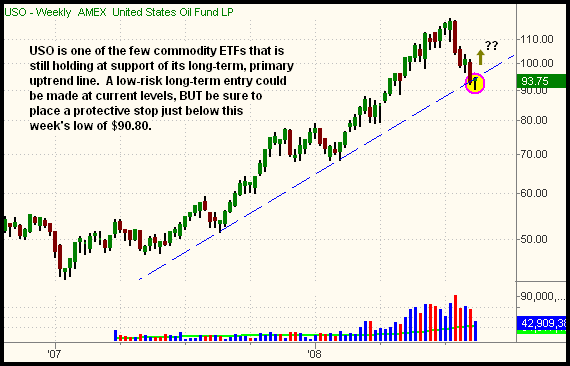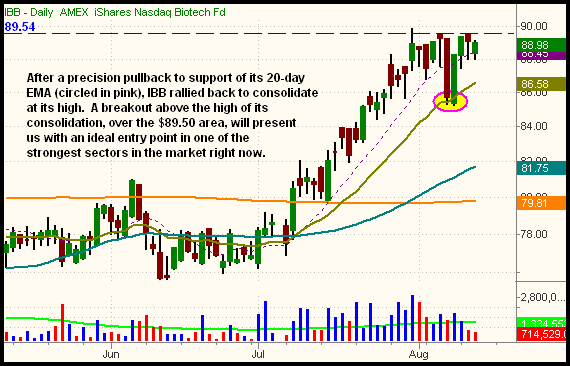Deron Wagner writes that after a recent correction down to their 20-day exponential moving averages, followed by a period of price consolidation, most of the biotech ETFs are now poised to break out to new highs.
Stocks got off to a rough start yesterday morning, but a mid-day reversal lifted the major indices back into positive territory. However, another round of selling in the final hour caused the main stock market indexes to finish with mixed results. The Nasdaq Composite, down as much as 1.0%, and up as much as 0.5%, settled with a fractional loss of 0.1%. The S&P 500 closed 0.3% lower, but the blue-chip Dow Jones Industrial Average fared worse, declining 0.9% by the closing bell. Small-caps continued to be the bright spot, as the Russell 2000 managed a gain of 0.4%. The S&P Midcap 400 similarly ticked 0.3% higher. In typical fashion of an indecisive session, the major indices finished near the middle of their intraday ranges.
Like the closing prices, turnover was also mixed. Total volume in the NYSE rose 7% above the previous day's level, but volume in the Nasdaq receded 3%. The S&P 500's loss on higher volume caused the broad-based index to register a bearish "distribution day," its third such day of institutional selling in recent weeks. Combined with the "churning" of August 11, the price to volume relationship of the S&P and Dow has become a bit more negative over the past week. Nevertheless, the Nasdaq managed to evade the same label of a "distribution day" because volume backed off slightly. In both the NYSE and Nasdaq, declining volume only narrowly exceeded advancing volume.
After getting totally pummeled by sector rotation and a strengthening U.S. dollar over the past five weeks, commodities finally bounced yesterday. But for those of you thinking this is the absolute bottom, and a good buying opportunity, we caution you to re-consider. Unlike other corrections over the past year, this one destroyed most long-term chart patterns. Advanced, ultra short-term traders may successfully trade the momentum of a quick bounce, but there is simply too much overhead supply to expect commodities to move much higher without first forming a multi-month based of consolidation. Consider the U.S. Natural Gas Fund (UNG), for example. It rallied as much as 75% this year, but now is showing a year-to-date gain of just 9%. In fairness, a 9% gain in an 8-month period is, in and of itself, a pretty decent return for any ETF in this environment, but the technical problem is that UNG gave back nearly all of its advance. Extensive overhead resistance levels will probably prevent UNG from going much higher for a long time.
One commodity ETF that still may be in play for the intermediate to long-term is U.S. Oil Fund (USO). Unlike many others, USO is one of the few commodity ETFs that hasn't broken support of its long-term uptrend line. In fact, it has begun to reverse right at lower-channel support of its primary uptrend line. This is illustrated on the weekly chart below (moving averages removed so you can more easily see the trendline): 
Those of you who think crude oil is just catching its breath and will continue moving higher may want to consider buying USO at its current level. If doing so, be sure to place a protective stop about a point below this week's low of $90.80. If USO breaks below this week's low, it will also break support of its long-term uptrend line, in which case you don't want to stick around. Still, if it holds support here, USO could have a decent shot at retesting its July 2008 high over the next six months or so. If it does, you'll have a very positive reward/risk level on the trade.
After a recent correction down to their 20-day exponential moving averages, followed by a period of price consolidation, most of the biotech ETFs are now poised to break out to new highs. This is illustrated on the daily chart of iShares Nasdaq Biotech (IBB) below: 
The obvious level to buy IBB, or any of the biotech ETFs, is on a breakout above the high of its recent consolidation. A protective stop can be place below support of the 20-day EMA (the beige line), presently at $86.58. Strong ETFs usually will find support at their 20-day EMAs before moving higher. Due to a less than ideal entry price, we recently got shaken out of S&P Biotech SPDR (XBI), but we'll confidently re-enter the biotech sector if these ETFs follow-through on their bullish consolidation patterns. In the meantime, we're maintaining a balanced portfolio with a bearish ETF position in financials (SKF), and a bullish one in healthcare (IYH). Both positions are showing a solid profit and looking good.
Open ETF positions:
Long - IYH, SKF
Short - (none, but SKF is a bearish position)
Deron Wagner is the Founder and Head Trader of both Morpheus Capital LP, a U.S. hedge fund, and Morpheus Trading Group, a trader education firm launched in 2001 that provides daily technical analysis of the leading ETFs and stocks. For a free trial to the full version of The Wagner Daily or to learn about Wagner's other services, visit MorpheusTrading.com or send an e-mail to deron@morpheustrading.com.